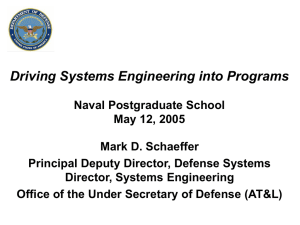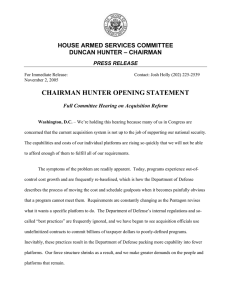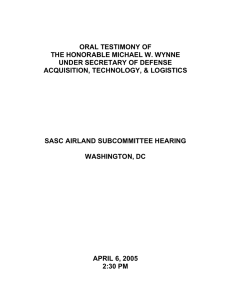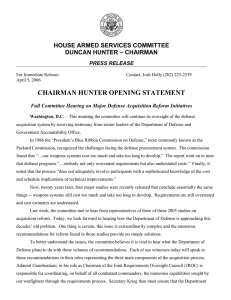Driving Systems Engineering into Programs
advertisement
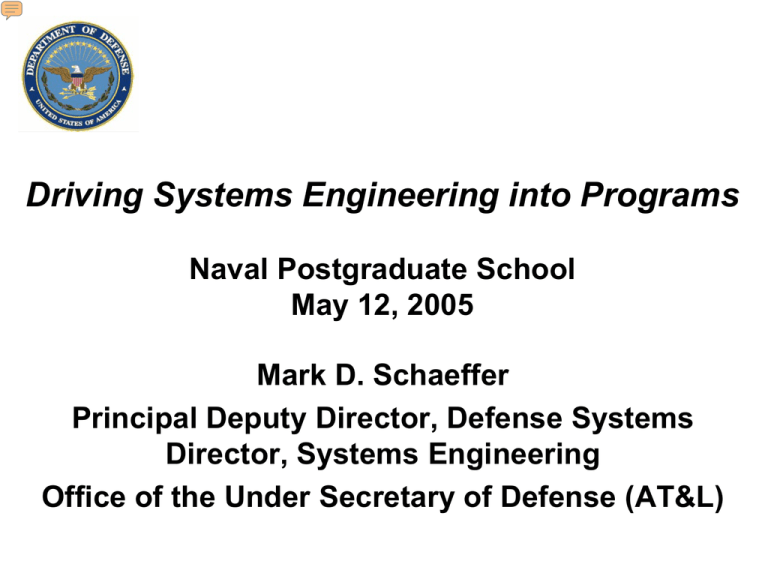
Driving Systems Engineering into Programs Naval Postgraduate School May 12, 2005 Mark D. Schaeffer Principal Deputy Director, Defense Systems Director, Systems Engineering Office of the Under Secretary of Defense (AT&L) Current Situation What We Need to Do Better Requirements • Adapting to changing conditions • Matching operational needs with systems solutions • Overcoming biases of Services and others • Moving to transform military PPBES • Laying analytical foundation for budget • Aligning budgets with acquisition decisions Personnel and Readiness • Treating people as a resource Acquisition • Acquiring systems-of-systems • Making system decisions in a joint, mission context • Transitioning technology • Assessing complexity of new work and ability to perform it • Controlling schedule and cost • Passing operational tests • Ensuring a robust industrial base Sustainment • Controlling O&S costs • Reducing logistics tails 2 USD(AT&L) Imperatives • “Provide a context within which I can make decisions about individual programs.” • “Achieve credibility and effectiveness in the acquisition and logistics support processes.” • “Help drive good systems engineering practice back into the way we do business.” 3 Top Five Systems Engineering Issues* • Lack of awareness of the importance, value, timing, accountability, and organizational structure of SE on programs • Adequate, qualified resources are generally not available within government and industry for allocation on major programs • Insufficient SE tools and environments to effectively execute SE on programs • Poor initial program formulation • Requirements definition, development, and management is not applied consistently and effectively 4 * Based on an NDIA Study in January 2003 DoD Systems Engineering Shortfalls* • Root cause of failures on acquisition programs include: – – – – – – – – – Inadequate understanding of requirements Lack of systems engineering discipline, authority, and resources Lack of technical planning and oversight Stovepipe developments with late integration Lack of subject matter expertise at the integration level Availability of systems integration facilities Incomplete, obsolete, or inflexible architectures Low visibility of software risk Technology maturity overestimated Major contributors to poor program performance 5 * DoD-directed Studies/Reviews How Defense Systems is Responding* • Instituted a new Systems and Mission Integration organization – Extends and complements work of former Interoperability Office – Engaging OSD, Joint Staff, Services, and COCOM staffs to define joint integrated architectures – Synchronizing the requirements, acquisition, and budget processes • Warfare offices (formerly Strategic and Tactical Systems) tailoring the application of DoD 5000 – Leading IPT process for program oversight and review – Role is to help programs succeed • Formed a new Systems Engineering organization – Institutionalizing Systems Engineering across the Department – Setting policy for implementation, capturing best practices, setting standards for training and education – Enhancing emphasis on system assessment and support 6 *USD(AT&L) Memo, Oct 4, 2002 Director, Defense Systems* • Principal advisor to the Under Secretary of Defense (Acquisition, Technology & Logistics) through the Principal Deputy Under Secretary of Defense (Acquisition & Technology) – Technical review, evaluation, and oversight of strategic and tactical DoD development and acquisition programs – Chairs Overarching Integrated Product Teams in the Defense Acquisition Board process – Enables effective joint and combined operations through the development of system of systems capabilities – Integration and implementation of policies regarding system integration and interoperability of systems used in coalition warfare – Facilitates timely and affordable fielding of effective warfighting capabilities by promoting the application of a sound engineering management approach to the Department’s acquisition process 7 * PDUSD(AT&L) Memo, Jan 29, 2003 Organization of the Defense Systems Directorate, OUSD(AT&L) Defense Systems Director Principal Deputy Systems and Mission Integration Joint Force Integration Joint Force Applications Air Warfare Dr. Lamartin Mr. Schaeffer System Acquisition Dr. Lamartin Director Dr. Garber Director Joint Force Operations Land Warfare & Munitions Enterprise Development Naval Warfare Plans and Operations System Engineering Mr. Schaeffer Director Assessments & Support Missile Warfare Developmental Test & Evaluation Treaty Compliance An integrated structure to develop capability 8 Director, Systems Engineering* • • • • Defines “good systems engineering” for the Department Finds, captures, and shares best practices Establishes systems engineering policy and procedures Implements education of government and industry workforce • Conducts outreach with industry, academia, associations, and others • Focal point for developmental test and evaluation • Provides program support to Program Managers Do things right 9 * PDUSD(AT&L) Memo, Jan 29, 2003 Developmental Test and Evaluation (T&E) • Critical part of systems engineering – Verifies system performance – Confirms design meets specifications – Provides traceability – Lowers life-cycle costs – Reduces technical risk – Provides indicator of technical maturity • Early involvement in SE planning is critical • Key determinant of successful Operational T&E T&E is integral to successfully fielding weapon systems 10 Modeling and Simulation (M&S) • New approaches to testing balanced with M&S – M&S to evaluate incremental products prior to fielding • Integrate M&S and T&E, early in the SE process, and test planning process • Mature, distributed, interactive, joint-test infrastructure • Maintain (and fund) M&S across program life-cycle • Improve M&S trustworthiness (VV&A) • Improve sharing and reuse of M&S—DoD and Industry • Establish standards 11 SE Education and Training Summit (October 2003) • Brainstorming session – – – – • Participants – – – – • What’s working What needs to be fixed Significant barriers Required actions Services Academia Industry Associations (NDIA, AIA, EIA, GEIA, INCOSE) Formed five working groups, assigned leads – – – – – Policy Processes Tools and guides Resources Education and training 12 “What We Found” Lack of Uniform Understanding of SE • Within DoD – Lack of coherent SE policy – Lack of effective SE implementation – Program teams incentivized by cost and schedule vice execution of disciplined SE – Products and processes not in balance (emphasis on speed; fix in next spiral) – SE inadequately/inconsistently considered in program life cycle decisions—prior to Milestone B and post Initial Operational Capability • Community-at-Large – No single definition or agreement on scope of SE – Lack of common understanding of SE implementation on programs – No consistent set of metrics or measures to quantify the value of SE – Cost and schedule estimation and risk management processes inconsistently aligned with SE processes – Multiple practioner communities not aligned 13 “What We Found” Resources Outweighed by the Challenges • Resources* • Challenges – Degreed workforce is a shrinking pool – System complexity is ever increasing – Ability to attract and retain young engineers in the aerospace industry is directly associated with the commercial marketplace – Network centric and extension of system applications are driving more integration – Existing university/industry partnerships are not having enough impact – Need new ways to attract and develop system engineers – Functional and physical interfaces expanding in number and complexity – New approaches to testing balanced with modeling and simulation must match new system of systems requirements 14 * Adapted from G. Shelton (Raytheon) DoD Response Policy and Guidance • Policy – Programs shall apply robust SE approach and develop a SE Plan – Each PEO shall have a lead or chief systems engineer – Event-driven technical reviews with entry criteria and independent SMEs unless waived by MDA – OSD shall review program SEPs for ACAT ID and IAM programs – Defense Systems shall establish a SE Forum • Guidance – Defense Acquisition Guidebook: SE in DoD Acquisition, SE Processes, SE Implementation in the System Life Cycle, SE Tools and Techniques, and SE Resources; Test & Evaluation – Systems Engineering Plan: interim guidance, Preparation Guide, and five focus areas to address in technical planning http://www.acq.osd.mil/ds/se 15 DoD Response Education, Training, and Outreach • Updating formal training updates across key career fields: SE, Acquisition, Program Management, Contract Management, Finance Management • Developing continuous learning, on-line courses: Reliability and Maintainability, Technical Reviews, and System Safety • Engaging several universities • Director-level outreach to industry – Hosting of and speaking at conferences and symposia – Speaking to industry at senior leadership levels 16 What We Have Done To Revitalize System Engineering • Issued Department-wide SE policy • Issued guidance on SE, T&E, and Systems Engineering Plans • Instituted system-level assessments in support of DAB, OIPT, DAES, and ad hoc reviews • Working with Defense Acquisition University to revise curricula • Integrating DT&E with SE policy and assessment functions—focused on effective, early engagement of both • Instituting a renewed emphasis on modeling and simulation • Leveraging close working relationships with industry and academia • Established SE Forum to ensure senior-level focus within DoD Necessary but not sufficient! 17 Driving SE Back Into Programs “Program Specific” • Defense Systems shall: – Lead program support reviews (PSRs) to identify and help resolve issues to ensure program success* – Review program SEPs for ACAT ID and IAM programs* • Program support strategy: – – – – – SE as captured in program technical planning (SEP) T&E as captured in verification and validation strategy (TEMP) Risk management—integrated, effective and resourced Milestone exit criteria as captured in Acquisition Decision Memo Acquisition strategy as captured in Acquisition Strategy Report Establish sound initial and total life cycle program structure 18 * USD(AT&L) Policy Memo, Feb 20, 2004 Driving SE Back Into Programs EARLY INVOLVEMENT PERSISTENT and CONTINUOUS INVOLVEMENT Increased use of disciplined SE, including formal technical reviews, to effectively address all technical issues 19 Driving SE Back Into Programs Importance and Criticality of the SEP • The program’s SEP provides insight into every aspect of a program’s technical plan, focusing on: – What are all the program requirements? – Who has responsibility and authority for managing technical issues and what is staffing and organization to support? – How will the technical baseline be managed and controlled? – What is the technical review process? – How is that technical effort linked to overall management of program? • A living document with use, application, and updates clearly evident THE SEP is the primary mechanism for SE revitalization by reaching every aspect of a program 20 Driving SE Back Into Programs SEP Focus Areas • Program Requirements – – – – – Capabilities, CONOPS, KPPs Statutory/regulatory Specified/derived performance Certifications Design considerations • Technical Review Planning – – – – – Event-driven reviews Management of reviews Technical authority chair Key stakeholder participation Peer participation • Technical Staffing/Organization – – – – – Technical authority Lead Systems Engineer IPT coordination IPT organization Organizational depth • Technical Baseline Management – – – – – Who is responsible Definition of baselines Requirements traceability Specification tree and WBS link Technical maturity • Integration with Overall Management of the Program – Linkage with other program plans – Program manager’s role in technical reviews – Risk management integration – Test and logistics integration – Contracting considerations 21 Driving SE Back Into Programs What are we seeing in PSRs and SEPs? • Incomplete discussion of program requirements – Missing categories such as statutory, regulatory, or certifications • Minimal discussion of program IPTs – Need to identify technical authority, lead systems engineer, and key stakeholders – Addresses part of SE organization, such as prime; no mention of government, subcontractors, or suppliers • Incomplete technical baseline approach – How does the program go from CDD to product—traceability – Linkage to EVM—not able to measure technical maturity via baselines • Incomplete discussion of technical reviews – How many, for what (should tie to baselines and systems/subsystems/ configuration items), and by whom (should tie to staffing) – Actual entry criteria • Integration of SEP sections – Linkage with IMP, IMS, logistics, and testing – Contracting for SE PSRs SEPs 10 19 22 Are We on the Right Track? • Study Findings – Inadequate understanding of requirements – Lack of SE discipline, authority, and resources – Lack of technical planning and oversight – Stovepipe developments with late integration – Lack of subject matter expertise at integration level • Programs/SEPs – Incomplete discussion of program requirements – Minimal discussion of technical authority and IPTs – Incomplete technical baseline approach – Incomplete discussion of technical reviews – Integration of SEP sections Strong correlation between initial findings and Program Support and SEP findings 23 Driving SE Back Into Programs Effecting ACAT IC, II, III Programs • OSD cannot do everything…NOR should we • OSD’s fundamental role is to set policy, provide relevant and effective education and training, and foster communication throughout the community • Service and agencies must take ownership of the institutionalization of SE • OSD will sponsor a PEO/PM Summit in May to: – Dialogue directly with PEOs, PMs, and technical authorities – Reiterate the tenants of SE Revitalization – Take aboard “feedback” from PEOs, PMs, and technical authorities – Conduct 1-day workshop to “work the details” 24 New Challenges • Applying SE to family-of-systems, system-of-systems, and capability-based acquisition • Modeling and simulation and SE • Contracting for SE • Determining value of effective application of SE • Institutionalization of SE Revitalization into all ACAT programs across all Services and Agencies 25 Summary • Our ultimate goal is to foster mission success through revitalization of systems engineering – Apply SE principles early and persistent to programs – Promulgate event-driven technical reviews with expert peer participation • The challenge is for DoD and Industry to effectively collaborate on the successful revitalization of systems engineering Systems Engineering for Program and Mission Success 26 Questions…perhaps Answers 27 Back-ups 28 Systems Engineering • Systems engineering is an interdisciplinary approach encompassing the entire technical effort to evolve and verify an integrated and total life-cycle balanced set of system, people, and process solutions that satisfy customer needs • Systems engineering is the integrating mechanism across the technical efforts related to the development, manufacturing, verification, deployment, operations, support, disposal of, and user training for systems and their life cycle processes • Systems engineering develops technical information to support the program management decision-making process Source: Acquisition Guidebook As adapted from EIA 632: Processes for Engineering a System 29 Technical Reviews Best Practice • Fundamental part of SE process and serve as technical assessment product for PMs • Should be event based—objective entry criteria need to be defined upfront Easy in principle, • Are only as good as who conducts them Difficult in practice – Engagement of Technical Authority – Chair independent of program team – Independent subject matter experts, determined by Chair – Involve ALL STAKEHOLDERS • Should review entire program from a technical perspective – Cost, schedule, and performance – Involve all technical products (specifications, baselines, risks, cost estimates) – By ALL STAKEHOLDERS • Should result in program decisions and changes—rather than a “check in the box” • Taken as a whole series, form a major part (backbone) of the SEP 30
